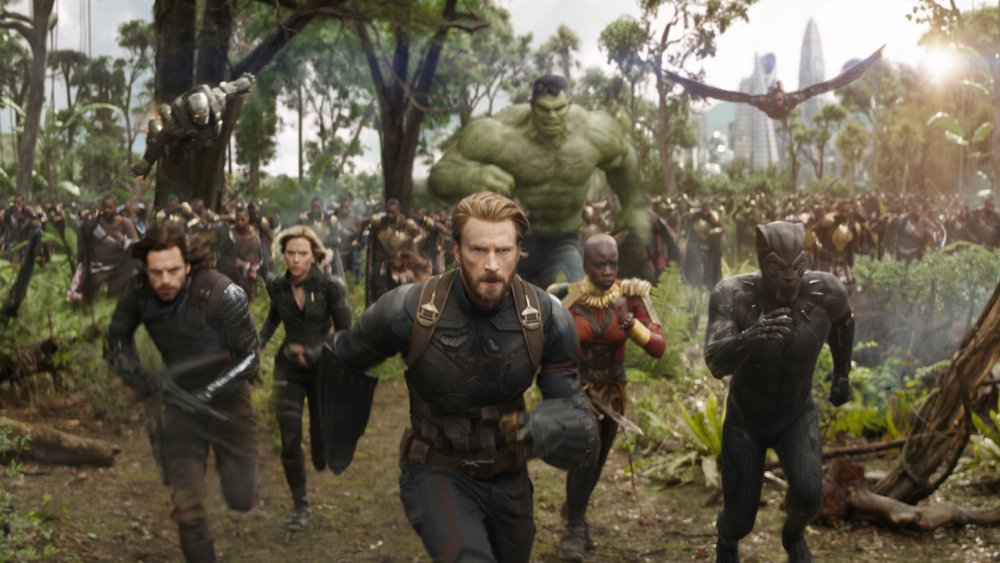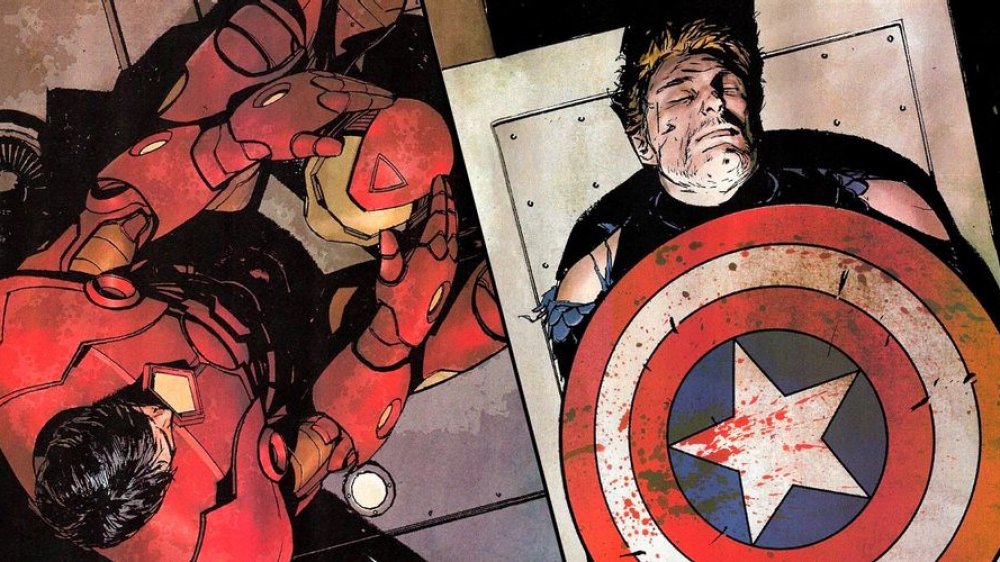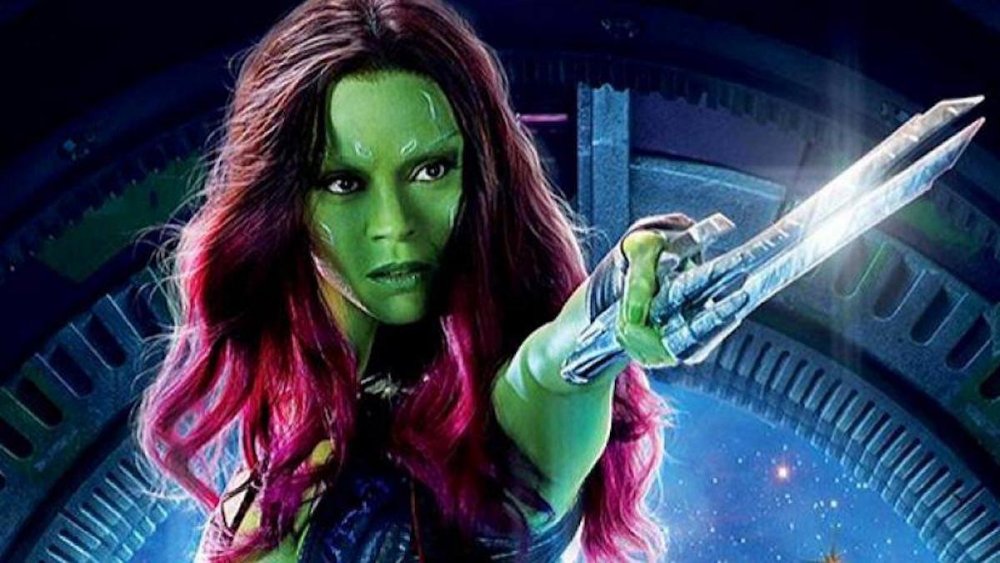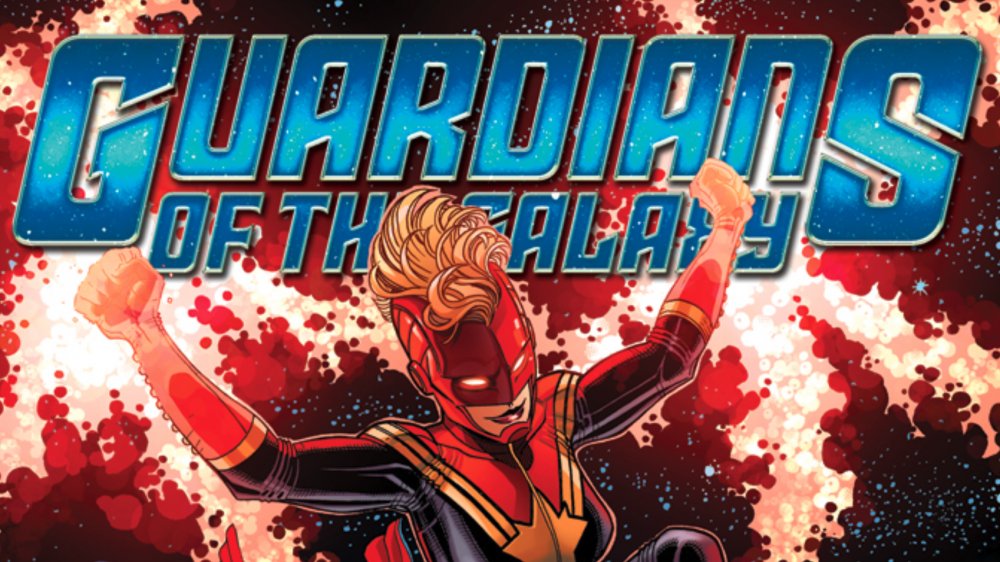Marvel Lied To You About The Avengers
The Avengers have launched countless comics and more than a decade of blockbuster movies. Over the years, Marvel heroes like Iron Man, Captain America, the Hulk, and Thor — and their MCU counterparts — have saved the world from destruction at the hands of alien invasions, fascist regimes, and all sorts of villainous shenanigans. Together, Marvel Comics and Marvel Studios have created an entertainment empire, but they've also lied to fans about their favorite characters through misleading trailers, comic book covers, and rewriting characters' backstories and motivations. Their most egregious lies often involve introducing elements of retroactive continuity, known as retconning, letting writers easily explain away plot holes or resurrected characters by rewriting past events or revealing villainous motivations that were hidden in previous storylines.
While some of these lies were relatively harmless, others completely changed decades of characters' narratives and backstories and inspired harsh fan backlash. Not all of these lies were bad — some of them ultimately made sense for writers and creators to achieve their artistic vision — but they were lies nonetheless. So let's take a look at all the times Marvel lied about the Avengers.
Hulk's confusing appearance in the Infinity War trailer
Infinity War was one of the most hotly anticipated films of the MCU's Phase Three. Fans were excited to see newer MCU heroes like the Doctor Strange, Black Panther, and Spider-Man join the fray. This hype was amplified by the trailer for Infinity War, which included a shot of Hulk and other Avengers running into battle Baywatch-style, with Cap leading the pack.
The only problem? Hulk is nowhere to be found for most of Infinity War, let alone the battle sequences shown in the trailer. At the start of the film, Hulk suffers an embarrassing defeat during a head to head battle with Thanos, and Bruce Banner is unable to revert back into his giant green form. (There's much debate over why Bruce can't turn back into Hulk during Infinity War, but that's a separate discussion entirely.) Bruce dons the Hulkbuster suit during the final battle against Thanos' forces, and the slo-mo ensemble running shot is nowhere to be found.
As for the reason behind the deception, the Russo brothers have said in interviews that they purposefully crafted the trailers of their Avengers films to minimize spoilers and keep fans guessing. This included using shots not found in the final cut of the movie and altering smaller details like Thor's eyepatch and missing Infinity Stones on Thanos' gauntlet.
Seriously, the trailers are made to fool you
The Russo brothers tricked viewers again with the trailers leading up to Avengers: Endgame, but this time around, most people almost expected it.
The subterfuge was necessary for the Russos to keep the gargantuan film event as spoiler-free as possible. This came as no surprise, as the Captain America: The Winter Soldier, Civil War, and Avengers: Infinity War and Endgame directors were notoriously anti-spoilers when it came to their movies throughout Phase Three.
Most of the shots featured in the Endgame trailers utilize unused footage from Infinity War, or altered scenes from the film's first act. The Russos' misleading use of scenes not in the final cut made sense, since using unaltered footage from the film's latter two acts would have likely spoiled both the film's jump to five years forward after the events of Infinity War and its time heist premise.
One of the most obvious misdirections from the Endgame trailer was Black Widow sporting her Infinity War-era bob, when in fact she'd gone back to her natural red color (with blonde tips, y'know, to show the passage of time). There's also a shot of Thor wielding Stormbreaker, and he looks a whole lot different than the beer-bellied Asgardian seen playing Fortnite in the film.
Steve Rogers' death in the Civil War comics
Marvel's history of deceit when it comes to the Avengers isn't exclusive to the Marvel Cinematic Universe. Throughout the decades, avid Marvel fans have been lied to countless times through misleading storylines and retcons that completely flip previously established canon on its head. One such retcon involved Captain America's tragic passing after the Civil War crossover event.
At the heart of Civil War's seven-issue conflict is the Superhero Registration Act, which required anyone with superhuman abilities to trust the U.S. government with their secret identities and regulate the presence and actions of heroes. Cap is against the Superhero Registration Act, which he sees as a grave infringement on the rights of people with superhuman abilities; one of his allies, Luke Cage, even sees the act as akin to slavery. During the fallout of Civil War, Steve Rogers is assassinated by a brainwashed Sharon Carter. This sets up the premise for The Death of Captain America, which spans 18 issues.
Rogers' death had larger implications for the Marvel universe, including the title of Captain America being passed down to Bucky Barnes. However, Marvel later brought Cap back by saying he hadn't actually died — the gun he was shot with didn't kill him, but rather suspended him in time and space, which kind of takes away from the emotional weight of The Death of Captain America series.
Tony Stark's betrayal in The Crossing
One of the more egregious retcons to plague the Avengers, The Crossing's reveal that Tony Stark had been a traitorous sleeper agent for Kang the Conqueror for 30 years went against literally everything readers knew about Iron Man. While retconning heroes as villains for a short narrative arc is commonplace in the comics, this instance was especially unpopular among fans.
Unlike other alternate-universe-evil-twin plots that comic book fans had come to expect over the years, The Crossing saw the real Tony Stark readers knew and loved betraying his friends and straight-up murdering people after three decades of deception. The explanation that Kang the Conqueror had been manipulating Tony for decades seemed a little thin, not only because of the rich backstory created and investigated thoroughly throughout years of Iron Man comics, but also because it completely disregarded any sense readers had of Tony's character development or morality.
Except not really? Marvel backpedaled on the idea that Tony Stark had been manipulated into being an evil double agent by Kang for the entire history of the Marvel Universe. Instead, the Avengers Forever miniseries further retconned this event and explained that Kang/Immortus' manipulation of Tony took place over several months, not years, further confusing and frustrating readers.
Captain America as Marvel's ultimate lie
Arguably the most controversial hero-turns-villain retcon in the Marvel Universe began with a now-infamous cliffhanger in Captain America: Steve Rogers No. 1 that sees Cap pledging his allegiance to Hydra. Throughout Secret Empire, we learn that Rogers had been indoctrinated to be a double agent for Hydra since childhood and was plotting against the Allied powers since the start. The idea that Captain America, a historically anti-Nazi hero created by Jewish writers, sided with Nazi-adjacent organization Hydra did not sit well with readers, with some seeing it as downright offensive to Captain America's original creators and the communities irreparably harmed by Nazism.
Attempting damage control, Marvel tried to argue that Hydra wasn't an explicitly Nazi organization, and that Cap's "Hail Hydra" moment wouldn't be trivialized for a bait-and-switch alternate timeline/universe Steve Rodgers narrative. Critics argued, however, that while Hydra's origins might have predated Nazism in the comics, their ideologies had become intertwined.
The truth of the matter of Cap's secret Nazism is a bit more complicated than it first appears, with the Cosmic Cube altering realities and Steve's memories. Still, Secret Empire rewrites history and says that the hero Captain America readers thought they knew was the biggest lie of all, and that HydraCap is Rogers' original form. By the end of Secret Empire, the story climaxed in a battle between Steves from different dimensions, but this lie still stung for many Captain America fans.
Black Widow's past as a ballerina was a lie
In Black Widow's initial origin story, Natasha Romanoff danced as a ballerina for the Russian Bolshoi before her time as a KGB spy-turned-Avenger. In early Black Widow storylines, readers learned that she married a Soviet agent and was a prominent ballerina, but later pledged her loyalty to the KGB and trained as a spy after the death of her husband. Black Widow's dancer past was even alluded to in the MCU during scenes from Avengers: Age of Ultron, when Wanda (Scarlet Witch) makes each Avenger experience a haunting vision to drive the heroes apart.
The truth behind Black Widow's backstory was much more sinister than either the original tragic origins or its MCU interpretation. In the comics, the reality of Black Widow's past is that Natasha was brainwashed, trained, and bio-technically altered to be a cold-blooded assassin from childhood by the Red Room. Fans had theorized that being a member of an internationally recognized dance company might make it difficult to moonlight as an assassin, but this was easily explained away by saying that all of Natasha's memories of the ballet had never happened: the false narrative Natasha initially believed about her past was planted by the Red Room to ensure her loyalty to the KGB. The lies Natasha was told about herself in this retcon will likely be crucial to the Black Widow solo film.
The source of Scarlet Witch's powers
Scarlet Witch's backstory has been retconned almost too many times to count. An integral part of Scarlet Witch's origins that people took for granted for decades was that she and her brother Quicksilver were Magneto's children, their mutant powers inherited through birth.
As Scarlet Witch would later star as an Avenger in the Marvel Cinematic Universe, this posed problems for Disney and Marvel — Fox owned the rights to X-Men and all mutant characters in the Marvel Universe up until Disney purchased Fox. When Marvel fans were introduced to Wanda in Avengers: Age of Ultron, her powers are shown to be the result of experiments by Hydra, not mutant genes.
In 2014, during the AXIS comics crossover event, Marvel turned Scarlet Witch's origin story on its head. Over the course of the story, Wanda discovers she's not actually Magneto's daughter, rewriting the fraught birth and childhood of the twins once again. This retcon also revealed that readers had been lied to about the origins of Scarlet Witch's powers. She previously had been portrayed as having some magical powers along with her mutant abilities, but the reveal that her biological connection to Magneto was a lie reinforced Marvel's growing emphasis on her sorcery.
Avengers Assemble #7's misleading Thanos cover
Starting in 2012, the Avengers Assemble comics endeavored to draw in new readers inspired by the first Avengers film, which came out that year. The cover from one of these issues, which features Thanos brandishing the Infinity Gauntlet with all the Infinity Gems, hits differently now for many Avengers fans than it did years ago. When Avengers Assemble was first published, Thanos hadn't even been properly introduced into the MCU, only seen in a brief cameo in an Avengers mid-credits scene.
MCU fans now recognize Thanos as the main villain of Infinity War and Endgame, the being who searches for the Infinity Gauntlet and gems to eliminate 50 percent of all beings across the universe — but comics fans are familiar with Thanos from the Infinity Saga on which those films are based.
However, in Avengers Assemble #7, Thanos doesn't possess the Infinity Gauntlet or the gems, contrary to the image on the cover. In fact, he's not even looking for them. He's actually looking for the Cosmic Cube, the all-powerful bauble referred to as the Tesseract in the MCU.
Nick Fury's eye injury in the MCU
How S.H.I.E.L.D. Director Nick Fury got his signature eyepatch has long been a topic of debate and analysis among MCU fans. In 2014's Captain America: Winter Soldier, some of the mystery behind Fury's eye injury was put to rest: Fury says in the film that the last time he trusted someone he lost an eye, and a photo suggests that Fury still had both eyes when he was sworn in as the director of S.H.I.E.L.D. However, 2019's Captain Marvel calls this story into question.
During Fury's Captain Marvel adventures, which take place long before he became the director of S.H.I.E.L.D., his face is scratched by a cute cat named Goose. As the film progresses, this seemingly surface-level injury becomes much worse, and Fury eventually loses his eye to it. As it turns out, Goose the Cat isn't really a cat at all, but an alien Flerken. While Fury's Flerken injury solved the years-long mystery of Nick Fury's eye for many fans, others were left wondering about Fury's previous statements from Winter Soldier. The evidence of patch-free director Nick Fury in the earlier Captain America film would indicate that Marvel either initially lied to viewers about where the injury truly came from, or it was a small enough detail that MCU writers felt comfortable rewriting the lost eye's cause in Captain Marvel. Perhaps we'll see this plot hole filled in Fury's Disney+ standalone series?
Gamora's retconned origin
Remember in the first Guardians of the Galaxy movie, when Gamora (Zoe Saldana) is introduced as the last member of her species, the Zehoberei? Marvel is probably hoping you don't, because they took her origin story in a different direction later on. As anyone who watched Avengers: Infinity War and Avengers: Endgame is aware, Gamora's adopted "father" Thanos was responsible for the destruction of her people — but instead of slaughtering all of them, as she claimed in Guardians, he's later shown in a flashback sequence, making the planet a stop on his long quest to bring "balance" to the universe by wiping out half of all life.
Either way, Gamora's story is tragic, and she had plenty of reasons to want Thanos stopped at all costs — but this seems like one of those times when Marvel hadn't really figured out the details of its sprawling cinematic universe, and made changes on the fly hoping most members of the audience would be too caught up in the action to notice.
Hulk's Quinjet adventure
Avengers: Age of Ultron isn't generally regarded as one of the best entries in the MCU, but it has its strong points — including the closing moments of the film, when the Hulk commandeers an Avengers Quinjet and heads off for parts unknown. He later turns up on Sakaar, where he's seen in Thor: Ragnarok as a sort of gladitorial all-star who battles all contenders for the amusement of the planet's citizens under the direction of the Grandmaster (Jeff Goldblum).
It's basically the MCU's version of the classic Planet Hulk storyline from the comics, and a turn of events that fans had long been clamoring for. It also wasn't initially supposed to be that way. As Marvel Studios chief Kevin Feige later admitted, when Ultron was made, the MCU braintrust had no idea where Hulk would end up — but they explicitly told Age of Ultron director Joss Whedon that he wouldn't be going to space. "If you go back and look at that shot of the movie, he's in the sky. It's blue sky," explained Feige. "In the movie, it's, 'We lost the signal out by the Caspian Sea.' Or something like that, it was all earthbound."
Here's one case when it seems safe to assume that most Marvel fans forgive the studio for lying to them — their change of heart gave us Thor: Ragnarok, after all.
Another misleading cover, this time with Captain Marvel
Misleading comic book covers were perhaps the original clickbait, historically drawing readers in with bright images of characters and scenes that weren't always depicted in the issues themselves. Such is the case with Marvel's Guardians of the Galaxy #15, which features Captain Marvel and announces her appearance in the tagline "And now ... Captain Marvel."
This Guardians of the Galaxy run highlighted teammates familiar to fans of the MCU, like Star-Lord, Drax, Gamora, and Groot, but it also ended up featuring a roster that included more surprising characters, such as Captain Marvel and Venom (yes, that Venom).
At the end of Guardians of the Galaxy #14, readers see Captain Marvel leaving to rescue Star-Lord. Readers logically expected her to arrive in the next issue, and the cover of issue #15 definitely seemed to hype up her involvement in the action. But her appearance in this comic is solely on the cover— she doesn't actually come to save the day until the next issue, Guardians of the Galaxy #16.
